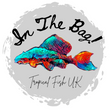In The Bag! Tropical Fish UK
Apistogrammoides Pucapullensis
- Regular price
- £12.00 GBP
- Regular price
-
- Sale price
- £12.00 GBP
- Unit price
- per
Couldn't load pickup availability
One male three females remaining!
Before placing an order please make sure you have read our Delivery, Terms of Service and DOA/Guarantee.
Delivery: How will my fish be delivered?
Terms of Sale: What happens if something goes wrong?
By placing an order you agree to these terms.
All measurements are total length including tail.
Please fully read this care guide to make sure you know how to care for the fish.
Potentially the world's smallest South American Cichlid, these tiny Apistogramma relatives are the only member of their genus. They have a preference for cooler water and don't necessarily need super soft acidic water, but their tiny stature and small mouth does mean some care and attention needs to be put into their setup.
Apistogrammoides Pucapullensis
Wild caught from Peru
Max Adult Size: 4cm (1.7”)
Temperature Range: 21 – 25 C no warmer, note this is different to Apistogramma which like it much warmer.
PH Range: 6.0 – 7.5
Water Hardness: 2 – 25 dGH
Flow Rate: Sensitive to low oxygen levels, so the use of a powerhead directed at the water surface, spray bar or vigorous air stone is advised.
Diet: Grazes on tiny larvae, daphnia, hydra and other aquatic critters. They have really small mouths so need crushed pellets, microgranules or crushed flakes. Supplementing with live foods is an excellent idea. Because they're very small it can be tricky to make sure they're getting enough food if they're in with busy community fish, but they also don't seem to be prone to overeating issues or bloat. They also seem pretty effective snail eaters as well!
Breeding: Straightforward, they breed like other SA cichlids, but the fry are insanely small, so you will need to be very careful about what filter you're using (sponges are probably best, like you would with shrimp) and also very careful about mulm build up etc while not sucking them out at the same time.
Notes:
Do not keep these with any other cichlids.
Do not keep these with fast or nippy fish like larger Tetras, Danios or Barbs. Anything much larger than a Neon is honestly going to be too much.
These would do best in a setup designed around them, with perhaps some Ottos and a couple of small dither fish like Ember Tetras or even small peaceful Rasbora like Galaxy/Celestials as they prefer the cooler temperatures as well.
Share










